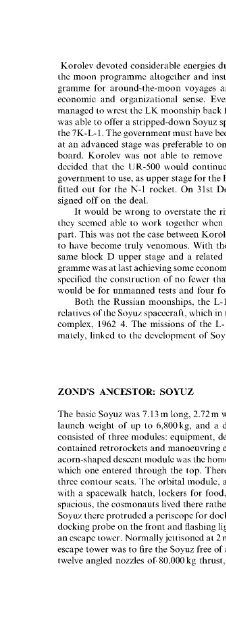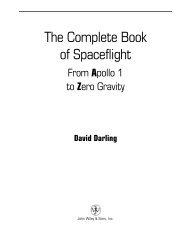Soviet and Russian Lunar Exploration
Soviet and Russian Lunar Exploration
Soviet and Russian Lunar Exploration
Create successful ePaper yourself
Turn your PDF publications into a flip-book with our unique Google optimized e-Paper software.
Korolev devoted considerable energies during 1965 trying to push Chelomei out of<br />
the moon programme altogether <strong>and</strong> instead for OKB-1 to run an integrated programme<br />
for around-the-moon voyages <strong>and</strong> l<strong>and</strong>ing, which he argued made more<br />
economic <strong>and</strong> organizational sense. Eventually, on 25th October 1965, Korolev<br />
managed to wrest the LK moonship back from the Chelomei design bureau. Korolev<br />
was able to offer a stripped-down Soyuz spacecraft as his alternative, which he called<br />
the 7K-L-1. The government must have been persuaded that a design that was already<br />
at an advanced stage was preferable to one that had barely got beyond the drawing<br />
board. Korolev was not able to remove Chelomei altogether, for the government<br />
decided that the UR-500 would continue to be used. Korolev also persuaded the<br />
government to use, as upper stage for the Proton, the block D upper stage then being<br />
fitted out for the N-1 rocket. On 31st December, Korolev <strong>and</strong> Chelomei formally<br />
signed off on the deal.<br />
It would be wrong to overstate the rivalry between Chelomei <strong>and</strong> Korolev, for<br />
they seemed able to work together when it mattered, albeit sullenly on Chelomei's<br />
part. This was not the case between Korolev <strong>and</strong> Glushko, whose relationship seems<br />
to have become truly venomous. With the man-around-the-moon project using the<br />
same block D upper stage <strong>and</strong> a related cabin, the 7K-L-1, the <strong>Soviet</strong> moon programme<br />
was at last achieving some economies of scale. The December 1965 agreement<br />
specified the construction of no fewer than fourteen L-1 spacecraft, of which seven<br />
would be for unmanned tests <strong>and</strong> four for manned circumlunar missions.<br />
Both the <strong>Russian</strong> moonships, the L-1 Zond <strong>and</strong> the LOK, were derivatives or<br />
relatives of the Soyuz spacecraft, which in turn was rooted in the designs of the Soyuz<br />
complex, 1962-4. The missions of the L-1 Zond <strong>and</strong> LOK were closely, even intimately,<br />
linked to the development of Soyuz.<br />
ZOND'S ANCESTOR: SOYUZ<br />
The basic Soyuz was 7.13m long, 2.72m wide, with a habitable volume of 10.5m 3 , a<br />
launch weight of up to 6,800 kg, <strong>and</strong> a descent capsule weight of 2,800 kg. Soyuz<br />
consisted of three modules: equipment, descent <strong>and</strong> orbital. The equipment module<br />
contained retrorockets <strong>and</strong> manoeuvring engines, fuel, solar wings <strong>and</strong> supplies. The<br />
acorn-shaped descent module was the home of cosmonauts during ascent <strong>and</strong> descent,<br />
which one entered through the top. There were portholes, a parachute section <strong>and</strong><br />
three contour seats. The orbital module, attached on the front, was almost circular,<br />
with a spacewalk hatch, lockers for food, equipment <strong>and</strong> experiments. Being more<br />
spacious, the cosmonauts lived there rather than the cramped descent module. From<br />
Soyuz there protruded a periscope for dockings, two seagull-like solar panels, aerials,<br />
docking probe on the front <strong>and</strong> flashing lights <strong>and</strong> beacons. On top of the Soyuz was<br />
an escape tower. Normally jettisoned at 2min 40 sec into the flight, the purpose of the<br />
escape tower was to fire the Soyuz free of a rogue rocket. A solid rocket motor, with<br />
twelve angled nozzles of 80,000 kg thrust, would fire for 5 sec.







